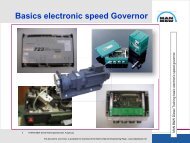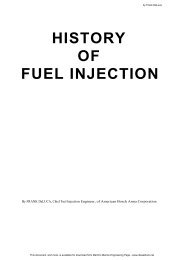Everything You Need to Know About Marine Fuels - Martin's Marine ...
Everything You Need to Know About Marine Fuels - Martin's Marine ...
Everything You Need to Know About Marine Fuels - Martin's Marine ...
You also want an ePaper? Increase the reach of your titles
YUMPU automatically turns print PDFs into web optimized ePapers that Google loves.
10. Hydrotreating<br />
A hydrotreating process is, as the name indicates,<br />
a process, which uses hydrogen <strong>to</strong> remove impurities<br />
from product streams, and replaces them with<br />
hydrogen. Hydrotreating is generally used <strong>to</strong><br />
remove sulphur (re very low sulphur limits in the<br />
specifications of gasoline and gasoil) and is then<br />
called hydro-desulphurization. It is a catalytic<br />
process. The process is generally used on kerosene<br />
and gasoil fractions. Residual hydro-desulphurization<br />
is an existing process, and is in theory feasible, but<br />
the economics are not favorable.<br />
11. Merox<br />
A merox unit is used on naphtha and kerosene<br />
streams. It is a catalytic process which is not<br />
intended <strong>to</strong> remove the sulphur from the stream,<br />
but <strong>to</strong> convert mercaptan sulphur type molecules<br />
(corrosive, and with a very obnoxious smell) in<strong>to</strong><br />
disulphide type molecules.<br />
12. Sulphur recovery<br />
As a result of the removal of sulphur from the<br />
refinery streams by hydrotreating, the generation of<br />
hydrogen sulphide during cracking and coking,<br />
refinery gases contain a very high concentration of<br />
hydrogen sulphide. The simple solution <strong>to</strong> eliminate<br />
the hydrogen sulphide (extremely <strong>to</strong>xic) is <strong>to</strong> burn it,<br />
but this then generates SO2, which contributes <strong>to</strong><br />
acidification problems. In order <strong>to</strong> safeguard the<br />
environment, the hydrogen sulphide is converted in<br />
refineries <strong>to</strong> elemental sulphur. This is typically<br />
accomplished by extracting the hydrogen sulphide<br />
from the refinery gas by a chemical solvent, e.g. an<br />
aqueous amine solution. The rich solution is then<br />
preheated and stripped by steam. The Claus process<br />
consists of the partial combustion of the hydrogen<br />
sulphide rich gas stream (sufficient air is introduced<br />
<strong>to</strong> combust 1/ 3 of the H2S <strong>to</strong> SO2). This SO2 then reacts<br />
(under influence of a catalyst) with H2S in the order<br />
of 1 SO2 for 2 H2S, and thus provides elemental<br />
sulphur. The tail gas of the Claus unit is still rich in<br />
SO2, and environmental legislation can require the<br />
further clean-up of this tail gas.<br />
22 <strong>Everything</strong> you need <strong>to</strong> know about marine fuels<br />
This document, and more, is available for download at <strong>Martin's</strong> <strong>Marine</strong> Engineering Page - www.dieselduck.net






